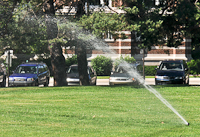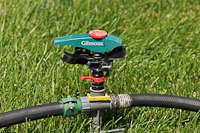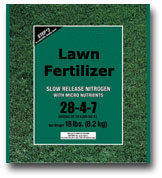True
or false? Lawns should be watered deeply and infrequently to
encourage deep rooting.
This has been
the accepted recommendation for a long time. Again, it sounds
so logical to apply enough water to penetrate the
 soil to 4 to
6 inches so that grass roots grow long enough to take
advantage of the moisture.
soil to 4 to
6 inches so that grass roots grow long enough to take
advantage of the moisture.
In the North, we grow cool-season grasses
such as
Kentucky bluegrass, perennial ryegrass and
fescue.
They add roots and the plants multiply during the cool of the
spring and fall. In the hot, dry summer, grass plants want to
go dormant and turn brown. During the hot season,
they may actually lose some of the roots they developed during
the spring.
Researchers at
Michigan State University and
other universities have now developed a modified approach to
lawn watering that seems to work best. They recommend deep
watering, if necessary, during the cool of the spring and fall
when roots are being produced. Generally, grass needs about 1
inch of water per week in the form of either rain or
irrigation.
 During the summer, to keep the plants green
and prevent them from going dormant, they recommend a light,
frequent watering. This may be 1/10 of an inch per day or 1/4
of an inch every few days. If possible, this routine should be
continued throughout the entire period of the hot summer. Some
people feel that to start this process and then stop during
the steamy days of August may cause considerable stress on the
grass.
During the summer, to keep the plants green
and prevent them from going dormant, they recommend a light,
frequent watering. This may be 1/10 of an inch per day or 1/4
of an inch every few days. If possible, this routine should be
continued throughout the entire period of the hot summer. Some
people feel that to start this process and then stop during
the steamy days of August may cause considerable stress on the
grass.
There also appears to be some benefit to
light, frequent watering when it comes to disease control.
Certain turf diseases are encouraged by water stress
especially during the heat of the summer. As the water
transpires (evaporates) off the surface of the grass blades,
it provides a cooling effect and helps reduce some diseases.
Watering the lawn also has an impact on how
much fertilizer to use. Don't forget that, unless the lawn is
being regularly watered throughout the season, the grass
plants are not capable of taking advantage of high levels of
nitrogen (see article on "fertilizer").
 Most
recommendations call for a range of 3 to 5 pounds of nitrogen
per 1,000 square feet of lawn per year. Generally,
non-irrigated lawns only need about 3 pounds of nitrogen per
year. This translates into 3 applications timed at about
Memorial Day, Labor Day and Halloween.
Most
recommendations call for a range of 3 to 5 pounds of nitrogen
per 1,000 square feet of lawn per year. Generally,
non-irrigated lawns only need about 3 pounds of nitrogen per
year. This translates into 3 applications timed at about
Memorial Day, Labor Day and Halloween.
For a lawn to be able to effectively use 5
applications would require irrigation. This almost always
means having an in-ground irrigation system with an automatic
control system.



